Weighing in at up to 40 pounds (though usually 8-15 lbs), the porcupine is one of the largest North American rodents, second only to the beaver. Erethizon dorsatum is perhaps best know for its quills which cover much of its body. This prickly protection usually keeps it safe from all but the automobile, for which quills are useless. In fact, about half of all porcupines I’ve seen were road kill. In the spring they crave salt, and sometimes make the unfortunate choice to visit the highway to get it.
The rest of the porcupines I’ve seen were in a den, on a tree, or casually strolling the forest floor. They’re not usually in a hurry, because they don’t need to be. Most attackers get a face full of quills. Its slow moving nature, arboreal tendencies, and general appearance are somewhat reminiscent of the totally unrelated sloth, though porcupines are not so slow as to harbor moss.
Porcupines usually inhabit forested areas over most of Canada and the western, mid-western, and northeastern United States, as you can see in its range map here. Here in Massachusetts, they seem particularly common the Quabbin Reservoir region. Check out our Wildlife Tracking Programs if you’d like to come learn with us!
This post contains links to online shopping, which is a way for you to support One Acre Farm at no additional cost to you. Click here for my full affiliate disclosure. Thanks for your support!
Porcupine Tracks and Sign
Porcupine tracks and sign are most easily observed in winter. These animals remain active all winter, and their runs, feeding sign, and scats are easy to see on snow.
Feeding sign
Nipped twigs
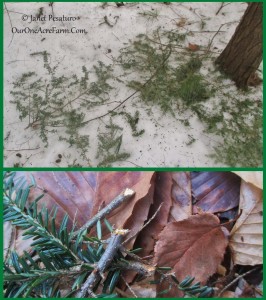
Porcupine nipped twigs litter the forest floor, under a favorite hemlock tree (top). Close-up of nipped hemlock twigs show classic angled cut. Click for larger view.
As an herbivore, the porcupine’s diet varies by season, according to the availability of plant foods. In summer, they may eat herbaceous plants in fields, but throughout the rest of the year, they feed on woody plants. They consume bark, twigs, leaves, buds, and mast (fruits, berries, and nuts) of trees and shrubs.
The porcupine is an excellent climber, but too heavy to venture out to the distal twigs. To reach coveted delicacies, it uses its sharp incisors to cut a length of twig. After feeding on the buds, young leaves, or mast, the animal drops the nipped twig to the ground. So, under favorite feeding trees, you can find these nipped twigs. Look carefully at the cut end of the twig nipped by a porcupine, and you will notice an angled cut, typical of twigs cut by rodents.
In fall, when porcupines eat a lot of acorns and beechnuts, look for nipped twigs under oak and beech trees. In winter, when they eat the foliage of hemlock and spruce, look for nipped twigs under these trees. In spring, you might find nip twigs under sugar maple, white ash, and aspen, from which they eat the buds and young leaves.
Porcupines are creatures of habit, often returning to feed on the same tree, night after night. These favored trees become so heavily pruned, that they develop a stout and stunted bonsai-like structure.
Bark
Like many other herbivores of the temperate forest, porcupines feed on the bark of woody plants in winter. In fact, they have gained notoriety among foresters for damaging trees in this way. You can’t miss the gleaming yellow, debarked patches on hemlocks and oaks in the stark winter landscape. They may feed on bark anywhere on the tree, and may (rarely) debark an entire tree.
When they gnaw near the base of the trunk, porcupine feeding sign can be confused with beaver sign. But porcupines gnaw only deep enough to feed on the nutritious cambium. The have no reason to gnaw into the wood. As excellent climbers, porcupines can access branches and twigs without taking the tree down. Beavers on the other hand, cannot climb, and must bring the tree to the ground to access twigs and branches for both food and building material.
Scat
Porcupine scat is produced in discrete pellets, especially in winter when they are feeding on the dry material of woody plants. The pellets are about an inch long. Some of them look like deer pellets, but many are curved and resemble a cashew nut in size and shape.
Tracks and trails
Porcupines tend to use the same feeding trees repeatedly, which makes their presence quite obvious. Where porcupines are present it’s easy to find these runs in snow. But because they travel over the same trails repeatedly, finding a perfect, un-trampled track is a rare event. I still kick myself over the lost opportunity for a photo of a perfect porcupine track in a dusting of snow. The tracks were so clear, you could see the pebbling on the bottom of the foot. But that was many years ago. I was a beginner, and did not appreciate the rarity of that finding.
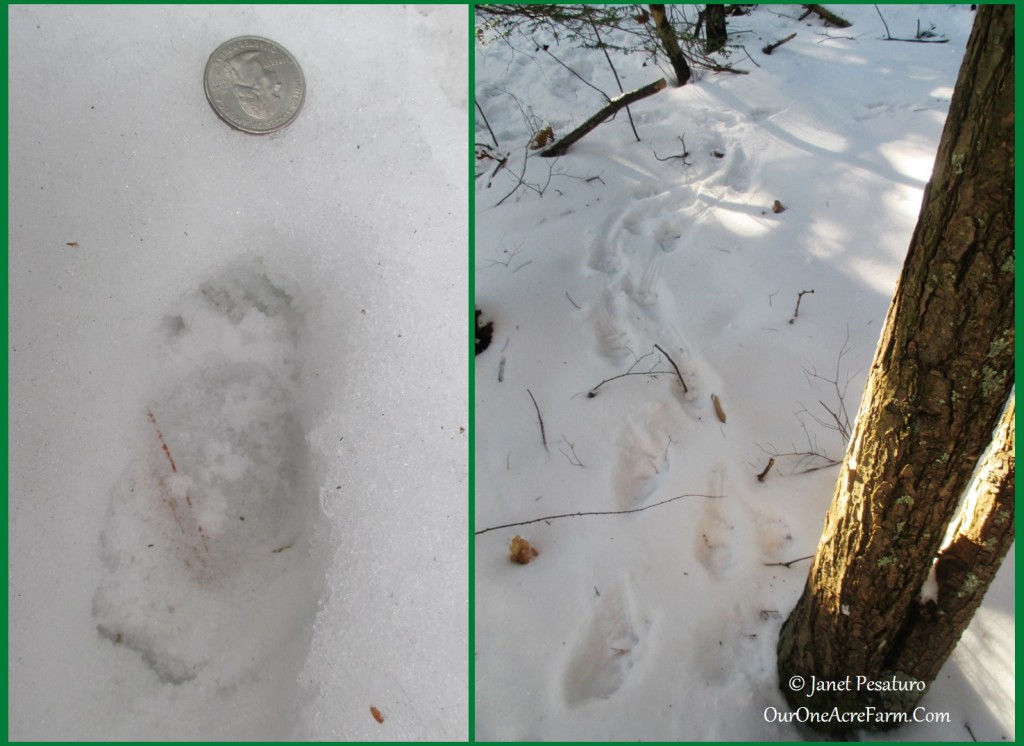
Hind track of porcupine, with quarter for scale (left). Porcupine trail between den and feeding tree (right).
Dens
Porcupines like to den close to a good food source, but other than that, they’re flexible in their choice of den site. In spring, a mother might leave her baby in the shelter of a fallen log, while she sleeps alone in a tree. In winter, porcupines seek shelter in ledge, between boulders, in cavities at the base of trees, under the roots of upturned trees, in outbuildings, and even in abandoned beaver lodges. In winter, they don’t seem to mind dens with wet floors, as long as the water is frozen.
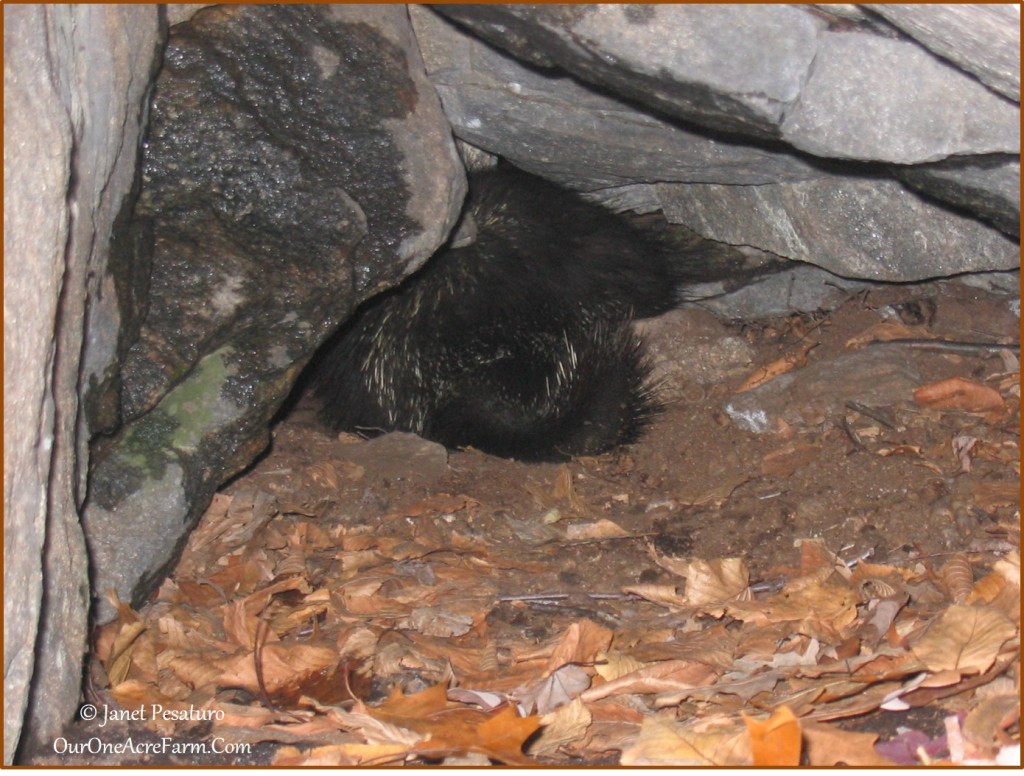
A porcupine in its den. As is typical, this animal has its face to the wall, and the business end facing intruders. No predator would take the risk.
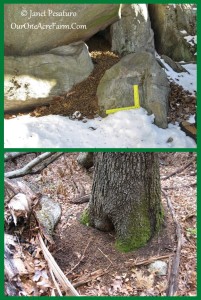
Porcupine den between boulders (top) with a huge amount of scat spilling out. Another den at the base of a hollow tree, with some scat (bottom).
Winter dens are used repeatedly, and porcupines make no effort to keep them clean. Scat will be evident on the floor, and sometimes it’s spilling out of the den in great quantity.
The scat accumulation in winter dens is an interesting issue. Some suggest that it’s of insulating value to the occupant, but it may be of no advantage at all. Perhaps there is simply no disadvantage to scat accumulation. It does make the den obvious to predators, but a porcupine in a den does not need to worry about predators. It turns its face to wall and displays its tail, and anyone who doesn’t want a face full of quills will not attack.
Quills
Porcupines molt their fur every spring, but drop quills here and there. You might notice a few among the scats of a well used den, and occasionally find one along a well worn run. Quills are stiff, lightweight, modified guard hairs, but they are not hollow, contrary to popular belief. They are actually filled with a spongy matrix of tissue.
Another popular misconception is that porcupines shoot their quills at predators. They do not. However, the quills do detach easily when touched, and microscopic barbs make removal difficult, once embedded in flesh.
Sources:
- Elbroch, Mark. 2003. Mammal Tracks and Sign: A Guide to North American Species. Stackpole Books. Mechanicsburg, PA.
- Reid, Fiona A. 2006. Mammals of North America. Houghton Mifflin Company. New York, NY.
- Roze, Uldis. 1989. The North American Porcupine. Smithsonian Institution Press, Washington, D.C.










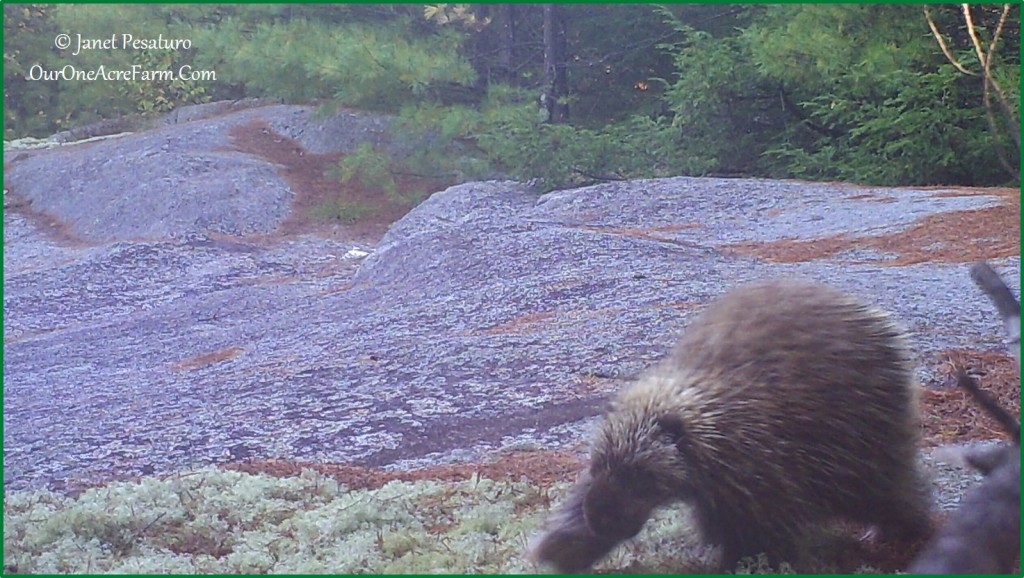
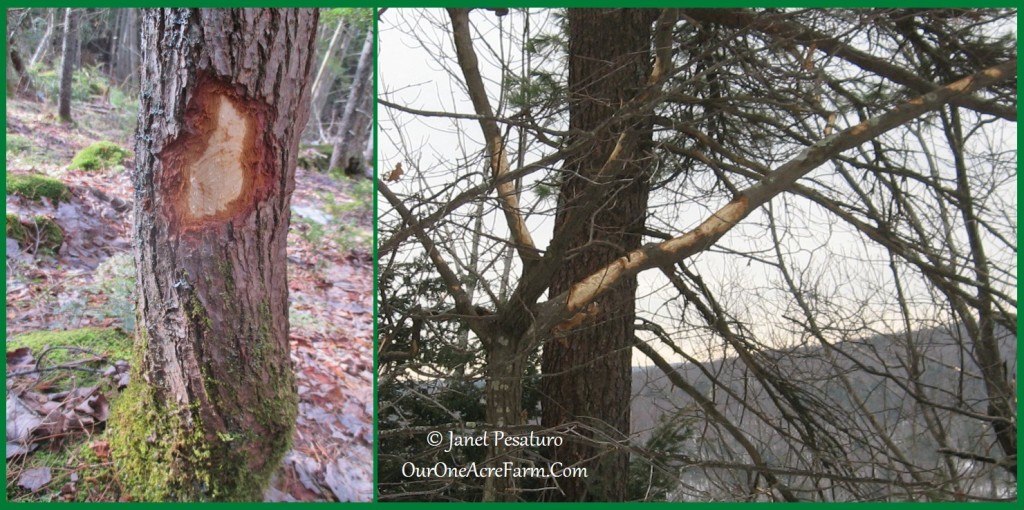
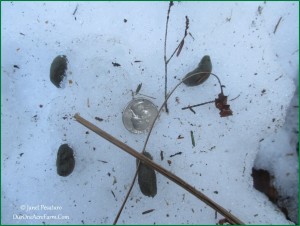
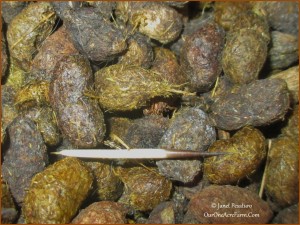
Thanks for the post. We have a porcupine somewhere in our neighborhood that’s been here for a while I guess since our neighbors first saw it a few years ago. Our cameras caught it stealing cat food off of our porch. He or she is very docile and shows no interest in our dogs or cats. I’d like to find where it is hiding out for the winter so I can leave some salt out in the spring because I really don’t want it getting injured trying to lick the ice off the road. I have no interest in trapping it or anything. I’m more fascinated than anything. Do you happen to know how far their range is?? Do they roam over large areas or will it be shacked up somewhere in my neighborhood? I like feeding the squirrels and skunks on our property. Obviously I don’t get too close since they are wild and deserve respect but I still like to look out for them
Hi Erin, they don’t necessarily have very large home ranges, but they do tend to move seasonally to access choice foods as they become available (they are herbivores). So they usually do not use the same den site year round. If you provide a salt lick, it would be best, in my opinion, to put it well away from both roads, houses, and human trails. Maybe you could use some of the information in this post to find tracks and sign this winter, then create the salt lick in late winter, before the animal moves to summer feeding areas. A lot of people don’t like them, so it’s not a good idea to attract them to where there’s a lot of human activity. They feed on certain trees – leaves, twigs, bark, and fruit, depending on season, and this does not endear them to people. Also dogs sometimes harass them, which can result in the dog getting a face full of quills. If you’re interested in wildlife, you might enjoy my new blog: http://winterberrywildlife.ouroneacrefarm.com/category/blog/
Pingback: Snowshoe to Smith Pond | Hemlock Adventures
What can you do to make your yard/neighborhood less desirable for a porcupine
I don’t know of a way to keep them out of your yard, but there may be away of preventing what it’s doing that you don’t like. At this time of year they visit people’s yards to chew on wood in order get the salts that are in wood preservatives. If that is what is happening, you could create a salt lick somewhere so the porcupines have a better alternative than your deck, shed, etc. There are instructions online for creating salt licks.
Their tracks show four toes on the front foot and five on the hind foot. Marks made by the long claws usually show. The heel pads have a pebbly texture. This acts as a non-slip surface and helps them climb trees. Sometimes, a tail drag mark is visible in the trail. Porcupine scat is in pellet form, and often found in piles at the base of a tree where the animal has been feeding. The picture above shows a tree damaged by a porcupine. This type of feeding sign is common.
My dog wants to play with a porcupine in my TX area and unfortunately has been sprayed with quills. Is there any recommendations to naturally keep them away or any other recommendations. Thank you
Unfortunately I have no advice on that (other than the obvious, which is to keep the dog leashed). Some dogs learn to avoid them, but others never learn. Just to clarify though: Porcupines do not spray or throw their quills. They have to make contact with an animal to deliver quills, which usually occurs when a predator attempts to attack. The porcupine faces its hind end towards the predator and slaps it with its tail. When the quills puncture the skin predator, they quickly release from the porcupine’s skin.
We live in the Berkshires in Massachusetts. Two weeks ago we saw a porcupine in our yard munching in the grass. It has been in our yard every day since, from morning to evening. Two days ago it was joined by a porcupine friend and now the two of them have been enjoying our yard all day long. My question is: I’ve read they are nocturnal and that it is unusual to see them during the day, so why are these two out in our sunny back yard. I find this fascinating!
This does seem unusual, all things taken together. They are mostly but not strictly nocturnal, and I’ve seen them during daylight a number of times. Eating in the lawn isn’t all that surprising either – mostly likely they are eating some herbaceous weed rather than grass. Two together is a little unusual, but here again, it’s not unheard of. I have many trail cam images of 2 porcs together. However, you have 3 different less than common events going on at once: daytime activity, 2 together, and eating on a lawn. The only thing that comes to mind is that maybe there is a salt source nearby. At this time of year they crave salt, especially lactating females, and they will congregate near important resources. Some sources of salt are road salt, treated wood, and paint. Are they licking salt from the road near your house? Gnawing on some structure on or near your yard?
Greetings from New Mexico! Growing up porcupines roll is something you see at a zoo for me, 10 years ago I saw one hit by a car on the highway and was shocked, but still didn’t think much of it afterwards. Until six years ago took my dogs went missing and after a four-hour search I found them both in separate bushes loaded with quills. (Luckily the vet lives right across the street from me) one of them only had about 12 in her really, but the boy how to mount 30 just in his mouth alone I took a hour or two to pick out the ones in his body unfortunately he passed away the next day. So I swore I was going to find it every last porcupine and rid them for good, then it dawned on me that I don’t even know the first thing about them so my research began and my hate for them turned into a passion that only grew deeper and deeper each passing day at now I will protect them with my life. So it breaks my heart that I have never actually seen one. maybe I have and just didn’t realize it because my brain probably moves faster than they do, but all signs show they are around. I had an extra salt lick from my horses but haven’t noticed if it’s been touched. I have conifers in my yard and 5 acres of grass hay. I’m right behind the irrigation ditch, I have a broken Adobe house covered in old dead/ dying trees to my left, and another abandoned lot full of logs and cottonwoods to my right. What am I doing wrong that I cannot seem to find them? I just want to see one, ever since I had a “conversation” teeth clicking back and forth with one when I was 26 years old. I’m 31 now and only get the pleasure of their lovely aroma at night,and piles of broken branches all over my yard in the morning. my whole family thinks I’m crazy, and imagining them, even my 10 year old. Any suggestions or advice how I can spot one? I’m without a camera right now.
Have you been able to find a porcupine sleeping spot? As described in the article, look for an accumulation of fresh scat. Then maybe you will see one if you sit quietly under cover somewhere and watch that spot.
Hey, I was wondering if there are any examples of people trying to interbreed the two species (porcupines and echidna’s) and if they have, if it was successful?
Porcupines are not closely related to echidnas, so they cannot interbreed.
I have a huge porcupine in my backyard. This critter & maybe it’s family have taken a liking to our trees. We do have lots of shrubbery, & other plantings. If there is anyone who would like this monster, they are welcome to come & get him. He has killed many huge pines & seems to have a never ending appetite.
So sorry. As you may have discovered by searching online, trees can be protected with a combination of poultry wire and electric fencing.
Excellent information. I will email you a picture of a Beech tree on my property, about 8″ in diameter that was completely stripped of its bark. You mentioned in your post that that’s rare.
While I don’t share your love for this little homewrecker, I do find them a very interesting creature.
I’m in Western Maine and my wooded property couldn’t be better habitat for them with a very prominent 250′ high rock slide that gives the many places to den. Fortunately they haven’t had to eat my house but my neighbor has some damage.
Hi Marc. Thanks for the photo – that debarking is impressive. I’m fascinated that you have a lot of them in your area within western ME because I just returned from a hiking trip in the mts of northwestern ME and I was surprised to see no porcupine sign whatsoever. I guess there must be pockets of porcupine abundance here and there, which is quite the same situation in my home state of Mass. To prevent them from eating human made structures, wooden tool handles, etc., provide a salt lick of sodium chloride. Mineral blocks for deer aren’t effective because they are richer in other minerals that don’t interest porcupines.
Excellent information on ‘porkys!’ My daughter and I spotted a popular ‘residence’ of a porcupine recently, including the typical pile of scat immediately outside the den of a huge oak tree! Your related descriptions above match our observations perfectly — at least in regards to the den area. We were not able to search the woods for any ‘favorite’ food trees because we were on an elevated walk structure in a state park! I am eager to share this info with her ASAP! Thank you.